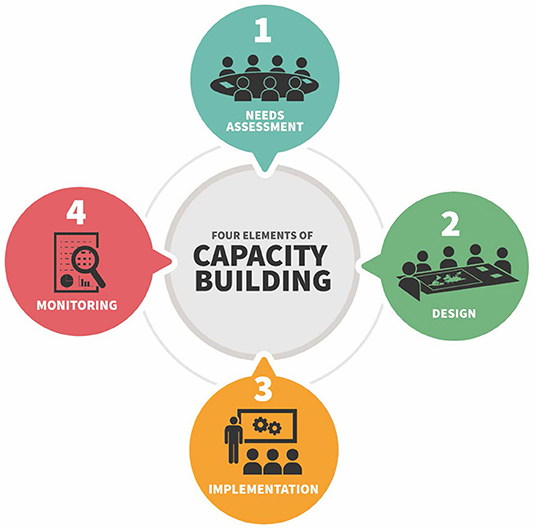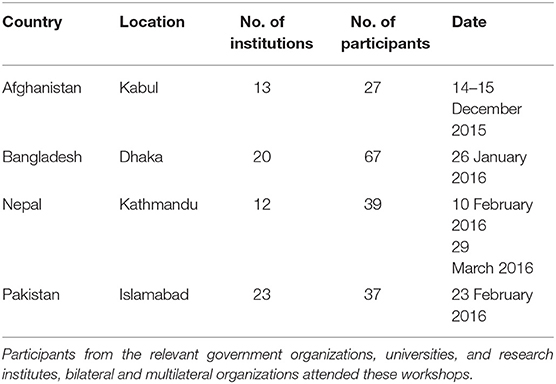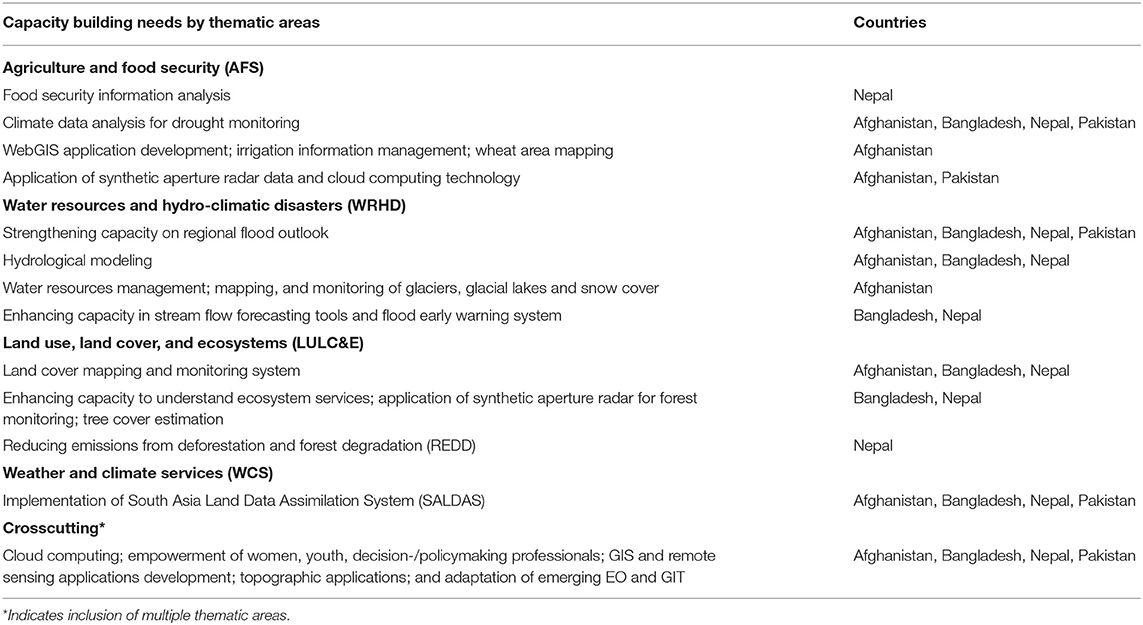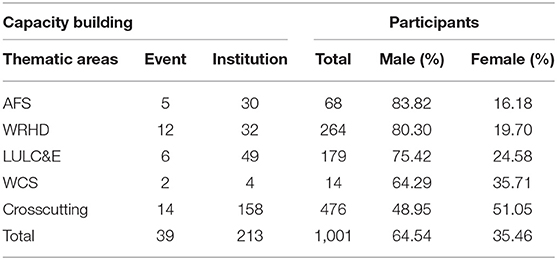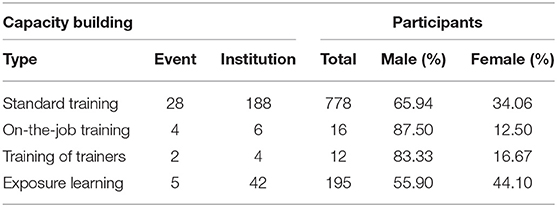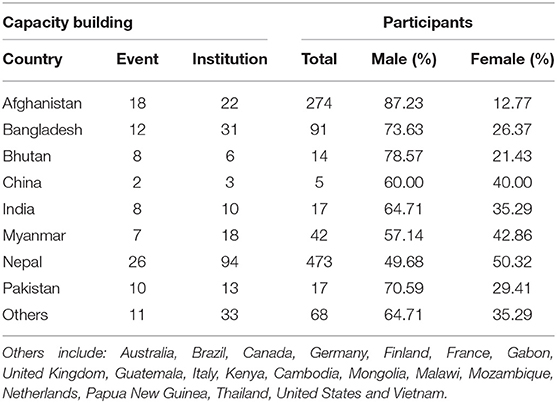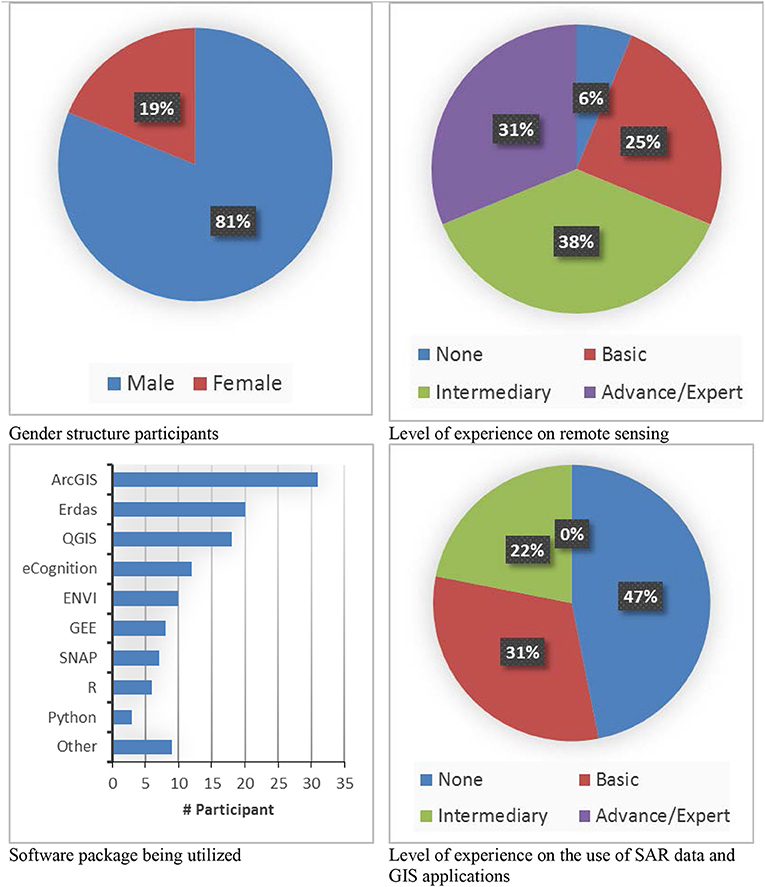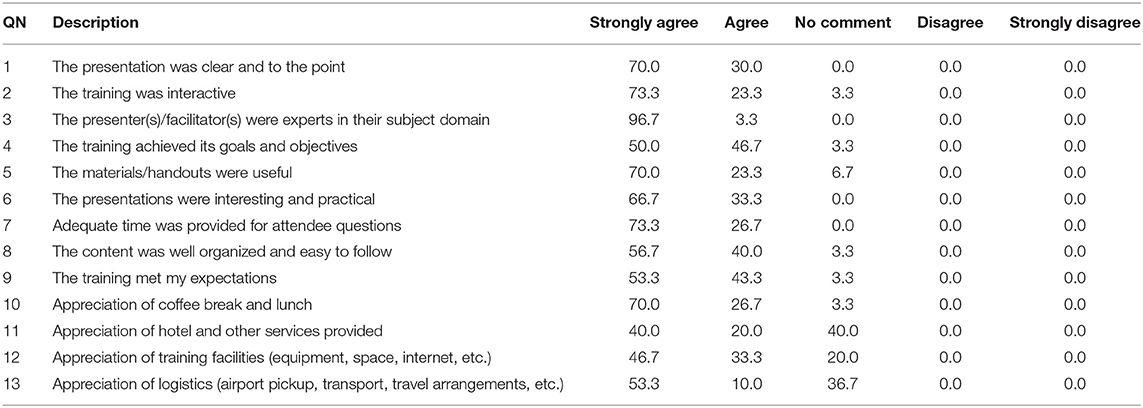- International Centre for Integrated Mountain Development, Kathmandu, Nepal
While the Earth observation (EO) data and geospatial information technology (GIT) are getting more open and accessible, lack of skilled human resources and institutional capacities are limiting effective applications in the Hindu Kush Himalayan (HKH) region. This paper aims to present the capacity building approach and applications designed to fill these gaps and empower decision makers and practitioners in using EO data and GIT through information education and training. The capacity building approach consists of four components: assessment, design, implementation, and monitoring (ADIM). The assessment component focuses on identifying the needs and priorities of capacity building for targeted groups or institutions. The design component develops training content in order to execute the plan in coordination with subject matter experts (SME). The implementation component executes the capacity building activity in any of these four formats—standard training, training of trainers, on-the-job training, and exposure learning. The monitoring component helps to identify the participants' expectations, learning achievements, and feedback so as to improve future capacity building events. In the application of ADIM, we conducted needs assessment in four countries, designed 26 types of capacity building contents and implemented 39 capacity building events. A range of thematic topics—from agriculture and food security, water resources and hydro-climatic disasters, land use, land cover and ecosystem, weather and climate services, to crosscutting issues—were covered in the events. Altogether, the activities reached out to over 1,000 individuals (35% of them women) from over 200 unique institutions in 30 countries. Institutional capacity was built for universities in Afghanistan and Bangladesh to design and deliver courses independently. The capacity of partner agencies were built to co-design and co-develop data and applications. The approach also experienced challenges in the nomination process and in identifying women participants due to the lack of women professionals in the field and in the respective agencies. The ADIM approach and its workflow focused on bridging the gap between the current trend and progression in EO and GIT fields and the existing state of capacity of the agencies involved in the decision-making process. It promoted gender equity, adopted frontier technologies, engaged SMEs and provided sustainable solutions, which are starting to bring success stories in the region.
Introduction
The increasing trend of extreme weather events and climate uncertainty poses new challenges for governments, communities, and individuals around the world. The mountain ecosystems of the Hindu Kush Himalaya (HKH) region is more vulnerable to climate change (Sharma et al., 2019). The Himalayan ecosystem houses a population of around 250 million people in the mountains; it is geologically fragile and experiences climate change and rapid social transformations driven by globalization, human conflicts, migration, infrastructural development, urbanization, and tourism. The complex interaction of these drivers is imposing major environmental and social consequences on the region. To mitigate these consequences, regional governments, communities, and individuals must work together whereby they can design and implement measures to adapt to change, deal with loss and damage, set up credible measures to monitor various parameters, adopt new technologies and methods, and raise awareness on climate change. Like other developing countries, the countries in the HKH region also lack the human, technical, and institutional capacities to deal with many of these challenges (World Bank, 2005; GEO, 2006; Merino and Carmenado, 2012; ECBI, 2018). Thus, they require customized capacity building approach and implementation programs which enhance organizational and technical abilities, as well as relationships and values that enable countries, organizations, groups, and individuals to carry out relevant functions and achieve their development objectives (Morgan, 2006; Balcazar et al., 2008; Whittle et al., 2012; Chandler and Kennedy, 2015). The challenges are multifaceted as they influence actions at local, subnational, national, and regional scales. The need for capacity building actions is highlighted in Article 6 of United Nations Framework Convention on Climate Change (UNFCCC), Article 10 of the Kyoto Protocol and Article 11 of the Paris Agreement. As the importance of information derived from Earth observing satellites and geospatial technologies is being widely recognized for supporting decisions on climate change mitigation worldwide, in this study, we focused on capacity building in the area of data utilization from Earth observation and geospatial information technology (EO&GIT). This paper aims to present the capacity building approach and applications designed to empower decision makers and relevant practitioners by providing them with geospatial data, tools, products, and services in order to act locally on climate-sensitive issues such as disasters, agriculture, water, land use, and ecosystems in the HKH region.
The HKH region covers the highest mountain range in the world where difficult terrain and high degree of inaccessibility present a formidable challenge to collect and manage data and information (Bajracharya et al., 2015). EO data, in combination with emerging GIT, helps to acquire information from remote regions and provides viable solutions to bridge the important data and knowledge gaps in the HKH region. The SERVIR-HKH Initiative (http://servir.icimod.org) of the International Centre for Integrated Mountain Development (ICIMOD), one of the five hubs (implementing agencies) of SERVIR Global (https://www.servirglobal.net/), is working on bridging the capacity and data gaps in the region. SERVIR is a joint development initiative of the National Aeronautics and Space Administration (NASA) and the United States Agency for International Development (USAID). It provides support to build the capacity of governmental institutions and other development stakeholders whereby EO data and GIT can be incorporated into the decision-making process; whereby free and open information sharing can be promoted through national and regional platforms and collaborations; whereby innovative, user-tailored analyses, decision-support services, and trainings that advance scientific understanding can be developed; and thus information can be delivered to those who need it (SERVIR Global, 2018).
Capacity building is an integral part of the SERVIR program globally as well as of the SERVIR-HKH Initiative for the HKH region. Capacity building for SERVIR-HKH refers to a process wherein the necessary skills and abilities are developed for using EO data and GIT in order to make and execute decisions that enable effective, efficient, and sustainable results. The initiative organizes training programs in the development and use of EO and GIT applications for partner institutions and end users to maximize the benefit of GIT in the region. The initiative provides technical support and conducts customized trainings, and also shares opportunities as per the needs of its regional partners. SERVIR-HKH strengthens the capacity of ICIMOD to forge better partnerships with the national institutions in the HKH. Capacity building efforts under SERVIR-HKH focus primarily on four thematic areas: Agriculture and Food Security; Water Resources and Hydro-climatic Disasters; Land Cover, Land Use and Ecosystems; and Weather and Climate Services. Capacity building is at the center of this whole initiative that supports institutions, communities and individuals in Afghanistan, Bangladesh, Myanmar, Nepal, and Pakistan (SERVIR-HKH, 2016). In an effort to meet the capacity building demands from these countries, we have designed and implemented an efficient capacity building approach. Details about the approach, implementation results, and the lessons learnt are discussed in the following sections.
Overview of Capacity Building Gaps and Needs in the Region
While developing successful capacity building in EO&GIT applications, we need to focus on the requirements of the national institutions and the end users of the system. The essence of implementing successful EO applications lies in the capacities of the implementing agencies and end users to maintain and utilize these applications to support the intended decision-making process. In the HKH region, a number of country consultation workshops were carried out in Afghanistan, Bangladesh, Nepal, and Pakistan to identify the national priorities, requirements, and gaps in terms of data, information products and the capacity of the institutions to utilize EO&GIT in supporting decision-making processes in the respective countries (ICIMOD, 2015, 2016a,b,c,d).
Data and Knowledge Gaps
The assessment of the institutions across the countries in the region showed varying degrees of geospatial capacities in terms of GIT infrastructure and human resources. Some gaps in geospatial capacities, including in the areas of data, and physical and human resources, were observed. For instance, most of the institutions in Bangladesh indicated that they needed hydro-climatic data on a daily and weekly basis in order to develop early warning forecasting products (e.g., for riverine floods, flash floods, and abnormal water surge in the coastal areas) and also to predict related vulnerabilities such as riverbank erosion, crop loss, and landslide hazards (ICIMOD, 2016a). Institutions in Nepal mentioned that they needed data based on elevation as there are big variations in terms of land and climate variables (ICIMOD, 2016b,c). Afghanistan's institutions mentioned that their agencies relied on annual data to produce geospatial products for irrigation planning and also for assessing the impacts of hazards such as drought, floods and landslides (ICIMOD, 2015). In some places, data was required on a daily basis, in some others it was seasonal, while in yet others, it was annual—so as to perform various kinds of spatial analysis and to produce final map products and services. There were also knowledge gaps in terms of EO&GIT applications at decision- and policy making levels. In the case of some countries, prominently Afghanistan, there was insufficient coordination between the universities and the government agencies.
Lack of Human Resources and Gender Equality
Many institutions in the region are lacking in strategy to sustain GIT projects as the majority of the geospatial applications are project based, thereby creating challenges in maintaining and upgrading GIT infrastructures, as well as in updating geospatial data and strengthening human resources after the completion of the project. Government agencies across the region have been finding it difficult to retain qualified professionals for a longer term in the field of EO&GIT. Besides, there is a large gender gap in capacity building as indicated by the educational attainment indicator of the region, where Bangladesh, Nepal and Pakistan are ranked 116th, 123rd, and 139th, respectively, among 149 countries (World Economic Forum, 2018). This is also reflected in the gender imbalance in the GIT workforce in the HKH region. Despite the vital role that women play in environmental management and decision-making, their involvement and participation in GIT is rather low. While the crucial role played by female professionals in geospatial applications is recognized, their numbers are still less in the institutions. Thus, capacity building and gender equality have been acknowledged as twin challenges in building pathways to sustainable development (ICIMOD, 2017). Capacity building that promotes regional cooperation and knowledge exchange via organizing trainings and workshops with the collaboration of the regional member countries (RMCs) will pave the way for the next generation to see more women in the sphere of science and technology, thereby bridging the gender gap.
Lack of Institutional and Technical Capacity
The provision for sharing geospatial data among the institutions in the region is poor. For instance, while Pakistan has fairly good capacities and infrastructure for using geospatial technologies, there are no platforms available for sharing data and products beyond single intuitional use (ICIMOD, 2016d). There is also a need to build geospatial capacities (infrastructural as well as in terms of human resources) in assessing the impacts of hydro-climatic disasters (e.g., flood-affected area mapping in Bangladesh, landslide susceptibility in Nepal, change detection in irrigated agriculture in Afghanistan) and in setting up early warning and forecasting systems in Afghanistan, Bangladesh, Nepal, and Pakistan. Furthermore, there is a lack of institutional capacity in the educational arena to institute a formal degree in geospatial technology. Presently, geospatial technology is being taught in the region through modules as part of other degree programs like in geography, water resources, and urban planning. Moreover, the curriculum for these modules are not up to date, and hence not in tune with the advancement in the field; the lack of trained faculty is also a limitation in this area.
In order to fulfill all the gaps and needs systematically and effectively, operational capacity building approach with verified applications on the use EO&GIT is necessary to strengthen the capacity of government institutions and other stakeholders in the region.
Materials and Methods
Keeping in view the diverse capacities of the institutions in the region, the gaps need to be bridged in a coordinated manner through customized training programs, institutional strengthening, coordination, and regional cooperation. The capacity building process must develop the skills and ability of the users of EO&GIT so that they can make and execute decisions that ensure effective and efficient results. There are many ways in which the capacity of the users can be built and they have been evolving over the years (Potter and Brough, 2004; World Bank, 2005; GEO, 2006; Balcazar et al., 2008; Wignaraja, 2009; Merino and Carmenado, 2012; Whittle et al., 2012; Chandler and Kennedy, 2015; Bergeron et al., 2017; Raynor et al., 2018). Here, we have opted for a strategy based on the lessons that have been learnt; so we have developed a sequential capacity building workflow (Figure 1) with four major tasks: Assessment, Design, Implementation and Monitoring—ADIM for short.
Assessment
The capacity assessment of the targeted institutions is very important to identify gaps, requirements, and priority needs for delivering effective capacity building programs. In this regard, four country consultation workshops (Table 1) were organized in 2015–2016 where gaps, needs, priorities, and capabilities of organizations, communities and individuals were systematically assessed. The need assessments were focused on the four thematic areas of SERVIR: Agriculture and Food Security (AFS); Water Resources and Hydro-climatic Disasters (WRHD); Land Use, Land Cover and Ecosystems (LULC&E); and Weather and Climate Services (WCS). The assessment process helped us to gain an understanding about the necessary EO&GIT products and services, physical capabilities (hardware and software), and the available human resources in the targeted organizations of the selected countries. The following specific activities were completed during the consultation process in each country:
• Introduced the overall framework and objectives of SERVIR-HKH to the relevant partner agencies;
• Assessed the existing context in the country in terms of the institutional capacity and expertise in the application of EO&GIT in various climate services; and studied the status of data availability and data access and sharing mechanisms;
• Identified the priorities for specific applications, products and decision support tools in the relevant thematic areas; and
• Explored potential collaboration with institutions to engage in the implementation of relevant capacity building activities.
The country consultation workshops helped to promote active user engagement in strengthening the on-going partnerships, building new ones and enhancing more engagements within the SERVIR-HKH team and with the users and other stakeholders. The partnership approach framework and principles were used in the workshops as one of the tools for fostering more engagements internally and externally, and for building awareness about capacity building among the SERVIR-HKH team and other stakeholders. With the feedback mechanism in place to know about the users'/partners' requirements in terms of specific applications, capacity building needs/demands were identified. This crucial information served as inputs to start on the Design workflow.
Design
After understanding the requirements from the assessment process, we, along with the SMEs, started designing the curriculum based on background notes, learning objectives, expected outcomes, targeted audience, and the daily agenda. The necessary materials (theoretical and hands-on exercises), including PPTs, manual, and exercise data, were prepared in modular approach with real-world examples for each activity. The training program devoted most of its time (60–80%) to hands-on activities. Here, four types of capacity building activities were designed: on-the-job training (OJT), standard training, training of trainers (ToT), and exposure learning.
OJT activities are semi-structured, focusing on building the capacity of partner institutes to enhance their capacity to develop, operate and maintain specific applications and services. They are designed keeping in view the background and skills of the participants. In OJT, the participants worked with the SMEs at ICIMOD on a rotational basis and learnt specific tasks objectively. After a certain period of guided training (1 or 2 weeks), independent assignments related to specific applications were handed out which were to be finished within a given period of time, along with the submission of a report. As for “standard trainings,” they are curriculum based designed for specific purposes; some are general remote sensing and GIS trainings while some are application oriented toward a specific subject or cross-thematic areas. Professionals from various backgrounds participate in these types of training. In addition, internships are also accommodated. In the case of ToTs, they are aimed to build the capacity of institutes to deliver training at their respective institutes and countries so as to reach out to more participants. These are designed for teaching staff from academic institutions and focus not only on content but also on skills related to the delivery of training (e.g., communication and presentation). After receiving such training, it is expected that the participants will be able to transfer knowledge to wider audiences in their respective institutions. In ToT, the participants are also engaged in refining training materials, for instance, in the development of hands-on exercises with local data and case studies. A ToT program is different from a standard training program as it includes additional contents in the form of adult training, scientific communication, and monitoring and evaluation; also, in this specific project, back-end support were rendered to the participants of ToT while they were conducting trainings in their home institutions. As regards “exposure learning,” it is of a short term and designed to make the participants aware of current development, applications, benefits, and future prospects of EO&GIT. And these activities were often organized alongside professional conferences, workshops, competitions and technical exchanges. In exposure learning, the competitions were meant for the youth; the conferences and workshops for decision- and policymaking professionals; and the technical exchanges for high-tech professionals.
While OJT and ToT were considered as institutional capacity building activities, the other two were considered as individual capacity building activities. The institutional capacity building activities were very specific and focused on the requirements of particular institutions; while the individual capacity building activities were more general in nature, linking thematic applications with common topics that cater to a wider audience. In this regard, we worked closely with the thematic leads and developed a training definition document (TDD) for each capacity building activity. The TDD provides a comprehensive capacity building activity plan that covers baseline information, requirements, participants, training schedule, gender considerations, activity inputs and the expected outputs from particular products, and services. In addition, in the case of some activities, we opted for a co-development module where multiple stakeholders such as in-house professionals, SMEs (Flores-Anderson et al., 2019) and user partners developed curriculum and training materials, and shared the resources. The use of open source GIS/RS software/platforms such as Quantum GIS, SNAP, and Google Earth Engine were encouraged in these activities.
Implementation
This refers to the execution of a capacity building activity. To implement the activities, we categorized participants into three groups: policy/decision makers; technical professionals; and youth. The makers of policies and decisions form a very crucial set of target audience who can greatly influence the successful implementation of any EO&GIT-related services in partner institutions. Therefore, to bring in the participation of the national institutions in utilizing the applications, it is important to make the leadership aware and convinced about these technologies and their potential applications. So, exposure learning events were organized for this category of participants. The technical professionals are those who are responsible for the development of databases and EO applications in different thematic areas; they run the applications and derive the products which can be used by the decision makers and general users. So, the OJT, ToT and standard training activities were offered to this category. As for the youth, their role as agents of change and effective communicators has been especially recognized in view of the emergence of numerous youth networks working on climate change. And as EO&GIT is a vital tool that improves our understanding about the climate change phenomenon, we organized exposure learning and standard training activities in this area, specifically targeting youth or early career professionals. Such as NASA SpaceApps challenge, miss technology, internship, selected training for young women (ICIMOD, 2018a) were organized for this group. Importantly, maintaining gender balance among the participants was given high priority. Strategically, we tried to ensure that at least 30% women took part in each capacity building activity.
Furthermore, the capacity building activities were organized at both national and regional levels. The national-level training courses were conducted jointly by ICIMOD and a local institute in the partner country. The selection of participants was based on the nomination process wherein we had invited nominations from ICIMOD's partner institutes in the region relevant to the training theme; but when the trainings had broader goals and required wider participation, the field was opened out. OJT, ToT, and exposure learning activities were based on nomination; while either nomination or open call or both were applied in the case of standard training activity. Sometimes, individual requests for internship were also considered in standard trainings. Based on the activity theme, basic eligibility criteria for participation were also set. And by using the basic principles of communication, we were able to ensure that the relevant training opportunities reached the targeted group of people; gender-sensitive language was used to encourage the maximum participation of women; we reached out to the disadvantaged groups too; and also conveyed our objectives to communities of practice and social media channels in order to gain a larger audience.
Monitoring
Monitoring and evaluation is an important part of any capacity building event. It helps to improve performance and achieve better results. Monitoring and evaluation has to do with the quality and relevance of capacity building efforts. Structured pre- and post-assessment tools were developed and used for each type of capacity building activity, except for the exposure learning type, in order to monitor a participant's expectations, his or her progress in understanding the contents, and to get feedback for continuous improvement. We conducted pre- and post-training evaluation surveys for each capacity building event so that the cognitive growth of the participants could be monitored and documented. A representative pre- and post-assessment results after the monitoring and evaluation practice from one of the capacity building activities is reported.
In this research, we also compiled and used data for results analysis from the country consultation reports (ICIMOD, 2015, 2016a,b,c,d) and the capacity building events data during October 2015–September 2018 (the first 3 years of SERVIR-HKH Phase II).
Results and Discussions
Capacity Building Needs and Priorities
During the country consultation meetings, several capacity building needs and priorities were identified and grouped into thematic areas (Table 2). Most of the needs and priorities—such as climate data analysis for drought monitoring in the AFS thematic area; strengthening capacity on regional flood outlook in the WRHD thematic area (SERVIR-HKH, 2016); and the South Asia Land Data Assimilation System (SALDAS) in the WCS thematic area—were common for all countries. In the case of three countries—Afghanistan, Bangladesh and Nepal—capacity building in land cover mapping and monitoring system, and hydrological modeling were in the priority list. We could also observe common needs and priorities in the case of Bangladesh and Nepal. However, many country-specific unique needs and priorities—such as WebGIS, water resource management, and wheat area mapping for Afghanistan; and REDD and food security information analysis for Nepal—were also identified.
Furthermore, the institutions in Bangladesh and Afghanistan insisted that more OJT programs for government institutions were required for the effective implementation of EO&GIT tools in their planned activities. Afghanistan stated that universities and training institutes needed to include EO&GIT in their curriculum in order to ensure the sustainability of capacity building activities; while Bangladesh required more trainings for university faculty so that they could replicate and disseminate capacity building activities in the longer run. In addition, during our assessments, we identified common needs and priorities of all countries in crosscutting areas such as, cloud computing, empowering women and youth and policymakers in the EO&GIT field, and enhancing the capacity to adopt emerging technologies.
Capacity Building Activity Design
Based on the results from the country consultation exercises, we designed 26 capacity building modules covering various topics from the thematic areas (Table 3). These modules were used to deliver OJT, standard training, ToT and exposure learning type of activities multiple times in the last 3 years. The AFS theme has five modules—two in OJT and the rest in standard training type of capacity building formats. Most of the modules consist of a daily training activity plan and associated materials in the form of PPT, alongside theoretical discussions and hands-on tutorials. In addition, the training module for climate data analysis for drought monitoring consists of a manual. Similarly, we designed six training activity modules for the WRHD theme. All these modules were used in the standard training program. Since the expected outcomes from OJT and ToT were different from the standard training program, the modules on “mapping and monitoring of glaciers” and “Remote Sensing and GIS for water resources management” were slightly modified to fit, respectively, into the OJT and ToT activities. All modules in this theme consist of PPT and hands-on tutorials to cover both theory and practice in the field. Also, detailed training manuals are available for three of the modules—hydrological modeling; mapping and monitoring of glaciers; and remote sensing and GIS for water resource management. Like the WRHD theme, six training modules were designed for the LULC&E theme, where five of them were delivered in the standard training format. A course on tree cover estimation was also developed for OJT activity. One of the five standard training modules, i.e., on land cover and land use mapping, was slightly modified to be used for ToT activity. All modules consist of PPT and tutorials. Besides, a manual was developed for land cover and land use mapping. The Synthetic Aperture Radar (SAR) for the forest monitoring module was covered by a part of the SAR Handbook (Flores-Anderson et al., 2019), a collaborative effort of SERVIR networks and partners worldwide.
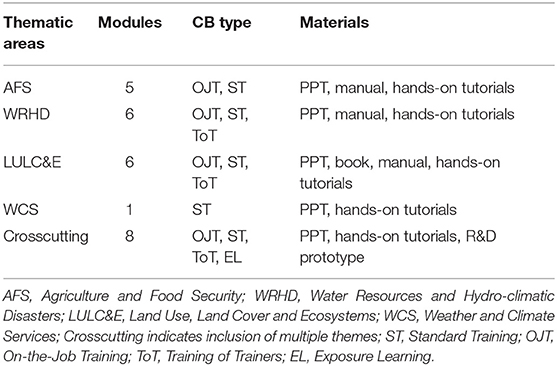
Table 3. Designing capacity building content, type, materials during SERVIR years (10/2015–09/2018).
The WCS thematic area consisted of only one course module as this theme has only one service (SALDAS). The module was in the standard training format and supported by PPT and hands-on tutorial materials. Among the total number of modules, eight are in the crosscutting areas. These modules deal with cross-disciplinary topics and are linked to more than one thematic area. Five modules were designed for the standard training format, while the Google Earth Engine module was extended to ToT activity with slight modification. The GIS application development module was designed for OJT activity. Under the crosscutting areas, the exposure learning visit type of capacity building activity was divided into two parts: capacity building conferences, i.e., Geospatial World Forum and Global Forest Observations Initiative; and competition events, i.e., NASA SpaceApp and “Miss Technology.” We closely collaborated with the event organizers for developing an agenda and supporting the activities wherein senior policymakers and technical professionals would get exposure learning on EO&GIT in the conferences and the youth would get exposure learning during the competitions. In the exposure learning type of activities, only PPT materials of corresponding conferences were available while the R&D prototypes developed through competitions were also available.
Capacity Building Activity Implementation
Using the course modules and materials, we implemented 39 capacity building events in the last 3 years (Table 4). These events served 1,001 people—a combination of technical professionals, policy/decision makers and youth—from 213 unique institutions in the HKH region and beyond. The participating individuals were from government ministries, departments and local offices, as well as from INGOs, NGOs, academic institutions, research organizations, and the private sector.
Most of the events (14) were crosscutting in nature and served half of the total institutions. Twelve events were organized within the WRHD theme where 264 participants from 32 partner institutions were engaged in various types of capacity building activities. The second major thematic area was LULC&E under which six events were organized to serve 49 institutions. Five capacity building events were organized under the AFS thematic area to build the capacity of 68 people from 30 institutions. Two capacity building events were organized under the WCS thematic area to train 14 professionals from four partner institutions.
In terms of gender, 35% of those who participated in the capacity building activities were women. This shows progress toward the goal of the Fourth Mid-Term Action Plan (MTAP) of ICIMOD which proposed to ensure 30% participation of women in event organizations (ICIMOD, 2017). While gender balance was observed in the crosscutting areas where female participants exceeded the number of male ones, more than 75% of the participants in the other thematic areas, such as AFS, WRHD, and LULC&E, were male. In this regard, we shall continue to strive toward ensuring gender balance in all the events by requesting partner institutions to make gender-balanced nominations, and by providing extra seats for women, implementing women-only programs and by establishing childcare facilities on campus. The participants in these capacity building events under the four thematic areas had been chosen based on the institutional nomination process where selection decisions were completely made by partner institutions.
As many as 28 out of the 39 capacity building events were in the standard training format (Table 5). This type of training alone served more than 778 participants, including 34% women, from 188 partner institutions. Standard training type of capacity building activities are often more general in content and serve various purposes of the EO&GIT applications. Therefore, it can accommodate greater number of participants and institutions. Exposure learning was the second major activity in the capacity building program. Through its capacity building-related competitions and conferences, it engaged nearly 200 people from 42 institutions. Here, as compared to other types of activities, a smaller gender gap was observed.
There were only two ToTs and four OJTs type of capacity building activities in the last 3 years. Since these two types of activities were very specific to particular institutions on EO&GIT applications, they served a lesser number of people and institutions. However, these activities were found to have an effective impact on the institutional capacity building of partner organizations. To ensure sustainability, we collaborated with our partner agencies for targeted capacity building on specific applications in order to set up self-managing information systems that could meet organizational needs. This was achieved through a combination of ToT and OJT. The ToT program helped to attain multiplicity in our training courses by developing trainers who could conduct courses independently and transfer the knowledge to a wider audience such as university students. We also collaborated with universities in the HKH region for the ToT program. We have successfully trained the faculty of Kabul University and Jahangirnagar University, respectively, in EO&GIT applications for water resource management and big data analysis using GEE. Thus, ToT and OJT types of capacity building activities are playing instrumental roles in institutional capacity building in the region. Through this process, Kabul University has independently organized training courses for its students and updated its curriculum on EO and GIS courses. Meanwhile, Jahangirnagar University has established an institute for remote sensing and GIS, while independent training programs were conducted in Bangladesh by trainers who had received ToT from SERVIR-HKH.
Although the SERVIR-HKH programs focused on Afghanistan, Bangladesh, Myanmar, Nepal, and Pakistan, they also provided capacity building services to other regional member countries of ICIMOD (Bhutan, China, and India) and beyond (Table 6). Among these countries, Nepal and Afghanistan were on the top of the list in terms of participation and events. Along with specific events organized for Nepali women and youth, many capacity building events were held in Nepal which eventually provided more opportunities to the professionals working in that country; thus, Nepal found itself on the top of the list. In the 26 out of the 39 events that were organized, we served 473 participants from 94 institutions in Nepal. As part of our special focus on EO&GIT capacity building of our Afghanistan partners, 274 participants from 22 institutions participated in 18 capacity building events. In the case of Bangladesh, the capacity building activities provided opportunities to a relatively larger number of institutions (31) where 91 professionals participated in 12 different types of activities. Among the countries within the ambit of SERVIR, Pakistan registered the lowest number of participants—only 17 professionals from 13 institutions attended the 10 capacity building events. This may be due to the lesser number of Pakistan-focused services in SERVIR and delay in product development. However, there is a push toward implementing more capacity building programs in Pakistan.
A significant number of institutions from Bhutan (6), India (10), Myanmar (18), and China (3) participated in various types of capacity building events. We also served some 33 institutions from 20 countries outside the HKH region on EO&GIT capacity building—some of them were Thailand, Cambodia, Vietnam, Mongolia, Malawi, and Kenya. In terms of gender balance in participation, Nepal was the most impressive, registering 50% women participants. Such a balance has been achieved through women-focused programs in Nepal such as “Miss Technology” and “Empowering Women in GIT” (ICIMOD, 2018a). The institutions from Myanmar and China maintained the minimum participation level of 40% women, while the number of women were very less from Afghanistan. This may be due to the fact that very few women are engaged in EO&GIT-related professions in that country; thus, more effort has to be put in to bring in more women from Afghanistan. Similarly, the participants from Bangladesh and Pakistan were mostly male−73.63 and 70.56%, respectively; here too, efforts are required to increase the participation of women.
Monitoring of Capacity Building Activities
Monitoring and evaluation is an integral part of capacity building activities. We conduct pre- and post-assessments of each type of capacity building activity, except for exposure learning visits. The pre-assessment provides guidelines about the participants' awareness and expectations about the capacity building content, while the post-assessment provides the level of knowledge acquisition by the participants and feedback for the purpose of improvement. In this paper, we present pre- and post-assessment monitoring and evaluation results from one of the 39 capacity building activities. It is a representative application of monitoring activity as it will be difficult to accommodate the results from each activity due to unique characteristics, response, and feedback.
A case from training on “SAR for Mapping of Forest Degradation and Deforestation” is presented here with details about its targeted audience, course contents and the results from the monitoring exercise. The training aimed to provide theoretical and practical knowledge so that SAR data and its applications could be effectively used to map forest degradation and deforestation. This 5-day training program covered theoretical background while providing hands-on knowledge about basic processing procedures using relevant data sets from active radar systems; it also outlined the limitations and error sources of each processing technique. Further, it covered various steps on SAR data processing and data analysis (ICIMOD, 2018b). The training was attended by 32 participants from SERVIR networks and partner institutes from ICIMOD member countries, including Afghanistan, Bangladesh, Bhutan, India, Myanmar, Nepal, and Pakistan. Two SMEs from US institutions were also brought in as resource persons.
We conducted two pre- and post-training evaluation surveys. These surveys focused on assessing the participants' level of knowledge and skills in the subject matter. This helped in understanding the overall experience of the participants. Figure 2 provides an overview of the composition of the participants and their technical skills before the training. Each participant responded to all questionnaires in both surveys. Due to various external reasons and the nomination process in selecting the participants, the gender structure of the training was largely imbalanced, as only about 19% women professionals took part in the program. In terms of remote sensing knowledge, most of the participants reported that they had either intermediary or expert level of knowledge. Almost all the participants were using ArcGIS for geospatial analysis in their works. Very few of them were using Python. About 53% of the participants were familiar with SAR data and GIS applications; the remaining participants reported that they had never used SAR data. From the survey, we found that most of the participants expected to gain theoretical as well practical knowledge about SAR data analysis for forest monitoring applications.
In the post-training assessment, 13 questions were related to the participants' response to the technical capacity building support (Table 7). The results show that the participants were satisfied with the training as all of them either responded with “Strongly Agree” or “Agree;” no one ticked on “Disagree” or “Strongly Disagree.” However, some of the questions, such as QN# 11–13, received “No Comment,” which was mainly due to responses from the residential participants from Nepal as they did not use the accompanying facilities such as hotel and transport.
Table 8 provides the results on whether the participants' knowledge and skill levels increased after the training. All the participants responded that their capacity had increased and assured us that they would apply the knowledge that they had gained from the training. Most of the participants agreed that they have learnt the basic principles of SAR and processing steps such as radiometric terrain correction, SAR data visualization and image interpretation, time series data analysis, forest change detection, Python scripting and automation, and the use of Jupiter notebook and Hype3 application. They also stated that they have acquired brief theoretical knowledge about interferometric SAR and flood applications. Some of the participants also wanted to learn about time-series data creation method, cloud processing system for bulk data analysis, use of artificial intelligence in mapping, methods of forest degradation mapping, and way to measure confidence intervals of change detection; besides, they wanted more tutorials on Python API for SAR processing and data cube. They also sought to learn about the procedures in data fusion of optical and radar, polarimetric and interferometric SAR for forest applications, biomass estimation and uncertainty reporting. They noted that SAR applications on forest reference emission level (FREL) and measurement, reporting and verification (MRV), biomass change detection, classification and mapping are very important, but had not been covered in the training. Thus, for the to-do list of future trainings, the following have been identified: advanced SAR data analysis; hands-on exercise with complete case study; operational SAR for forest applications; coding to access voluminous data; more scripting for large-scale data processing; automated system for forest degradation identification; forest health monitoring using SAR; and more discussions on cloud computing implementation. One of the shortcomings some of the participants pointed out was that the time for discussions was too short.
All these primary pieces of information derived from the pre-assessment survey were very helpful in refining the training module during the training period itself to meet the expectations of the participants. The results from the post-assessment survey were helpful in improving the next training module. In addition, we are planning to conduct tracer surveys to understand the status of capacity building in the past 3 years. The relevant questionnaire of this survey will be sent to all the participants who attended any of the 39 training programs. Furthermore, institutional capacity assessment using OCAT (Organizational Capacity Assessment Tool) is also planned to examine the long-term impact of the capacity building activities on select partner institutions in Afghanistan, Bangladesh, Myanmar, Nepal, and Pakistan.
Challenges and Opportunities
We have presented the approach adopted for building the capacity of individuals and organizations on EO&GIT in the region where 39 events were conducted successfully in the last 3 years. Some institutional success stories, from establishing a GIS lab to preparing a glacier data inventory, and many more are documented in http://servir.icimod.org/stories. However, there are many challenges and opportunities that we learnt about while implementing the capacity building activities.
Challenges
Bringing the key stakeholders to the meeting table for consultations and engaging them in prioritizing the capacity needs of their country was a big challenge. In some cases, it was also difficult to get policy-level people who could provide wider inputs on capacity gaps and the EO&GIT needs of the country.
Influx of variety of EO data and emerging GIT are making challenges to keep frequent updating capacity of individuals and institutions. When new technologies emerge, new curriculum, materials and programs on capacity building become necessary, but they are ultimately resource intensive and the appropriate SMEs may not be available immediately.
OJT, ToT, exposure learning and most of the standard trainings were nomination based, which made it difficult to ensure gender balance in certain capacity building events. Furthermore, sometimes, we received nominations of less relevant people for highly technical training modules. Geopolitical tension between some of the countries in the region was also a major challenge—it made difficult to ensure the participation of particular countries within the stipulated time frame. In the HKH region, while there are lesser number of women professionals in the EO&GIT field, there's also the added factor of women having more social and religious obligations than men; thus, bringing more women to the capacity building events was also a key challenge.
Moreover, the region has diverse sociocultural systems, so we had to pay special attention to this context while organizing a capacity building event. Sometimes, language was also a barrier. We provide best efforts to engage resource persons with multiple language skills, however, some time it becomes either difficult or cost intensive for language translation services.
We also received the feedback that after investing much resources in capacity building, many organizations in the region were facing challenges in retaining technical professionals for a longer tenure. Retaining technical professionals is a key challenge in the region because of reshuffle, promotion, and administrative engagement of professionals within the organization, transfer of professionals into other organization, and lucrative opportunities outside the organization. Challenges were also faced in the monitoring and evaluation aspect of capacity building activities, as some participants were either reluctant or less motivated to provide true responses to the survey questionnaires.
Opportunities
The country consultation meetings provided opportunities to bring the stakeholders closer and engage them in the assessment of capacity building gaps and needs in their respective countries. Their priority list helped in the designing of activity and in the smooth implementation of plans. They ensured demand and ownership which eventually helped them to include capacity building experiences in their workflows.
The capacity building activities also provided a platform for people from various segments and contexts—from young men and women, experienced professionals and technicians, to policymakers—to work together in the larger interests of the region; this helped in achieving great benefits from a small investment. The influx of a wide variety of EO data, tools and literature provided cost-effective choices on developing training materials and implementing capacity building activities in some resource-starved areas. The co-organization of capacity building activities had multiplier effects in terms of learning, value-added knowledge and a greater feeling of ownership among the stakeholders.
The EO&GIT communities are now moving toward open access tools and data which reduces the cost of capacity building of individuals as well as institutions. As for the nomination-based selection process, it reduced the liability of selecting the right participants from the partner institutions. Meanwhile, employing the services of SMEs brought cutting-edge expert knowledge to the region.
As the number of women engaged in this field is rather less, there is a vast opportunity to design women-focused capacity building programs which can empower them in the field of EO&GIT and nurture a gender-balanced workforce in the future. In terms of multicultural participation in the capacity building events, it provided a great opportunity to interact with people from different social backgrounds and countries, which ultimately strengthened partnerships and professional networks. The monitoring and evaluation process provided the opportunity to understand the expectations and learning achievements, trace the impacts of the activities, and consider the necessary measures that must be taken in future capacity building plans.
Conclusion and Way Forward
The simple but robust ADIM (assessment, design, implementation, and monitoring) approach presented in this paper was able to cater to the needs as is evident from the results. This innovative approach identified gaps and needs, designed efficient capacity building activities, implemented the plans to achieve a lasting impact and monitored the delivery results so that a feedback mechanism could be established. This approach is cost-efficient, sustainable and gender balanced, and so should go a long way in securing effective workforce development. The complete workflow focused on bridging the gap between current trends/progressions in the EO&GIT field and the existing state of capacity of the agencies involved in the decision-making process. The OJT and ToT type of capacity building activities played a very important role in institutional capacity building. The standard training type of activities were powerful in building individual capacity and improving the gender balance in the technical professional workforce. The exposure learning visit brought young people together and provided a competitive environment of learning wherein they gained and shared knowledge among themselves and others. In addition, this type of capacity building program brought together high-level policy/decision makers, and they were exposed to and became aware of emerging geospatial technologies—thus, they are now capable of integrating such technology in their institutional workflows. Our approach was successful in delivering capacity building activities based on the priorities of our partners, and this should strengthen the ability of governments and development stakeholders in the region to sustain the program. By engaging global experts as SMEs and building the capacity on the use of EO&GIT in the region, we have laid a strong foundation for positive technological interventions. Despite the challenges, the approach was able to provide capacity building services to a large number of unique organizations and communities worldwide; it will also pave way toward a more gender-balanced workforce in the future. The paper reveals the several opportunities that arise from capacity building activities—from sociocultural experiential learning to the use of frontier technology. Our approach promoted gender equity, adopted frontier technology, engaged SMEs and provided sustainable solutions, all of which will have a positive bearing on the region. Apart from this effective capacity building approach, the detailed sharing of unique experiences will be of great help to capacity building practitioners in the HKH region and beyond.
As for the way forward, there is still much that needs to be fixed improvement in the coming years. Regular organizational capacity assessment (OCA) and tracer surveys, at least once in 5 years, are mandatory to monitor the periodic impact of the capacity building efforts in the region. In fact, we have already started conducting OCA and tracer surveys. There's also the avenue to set up an interactive web-based training portal to host existing and upcoming training materials for wider distribution. Such a portal would enable video-based online tutorials whereby the users can learn by themselves about all the aspects of capacity building. And that will surely have a path breaking impact on building capacities in the region and beyond.
Data Availability Statement
The datasets generated for this study are available on request to the corresponding author.
Author Contributions
RT, MM, and BB design the conceptual framework of the manuscript. RT collected the data. All authors analyzed the data and wrote the manuscript.
Conflict of Interest
The authors declare that the research was conducted in the absence of any commercial or financial relationships that could be construed as a potential conflict of interest.
Acknowledgments
We, the authors, wish to thank our reviewers for their creative comments and suggestions that helped us to improve this manuscript. We are also thankful to the entire SERVIR-HKH team, the SERVIR Science Coordination Office and all the subject matter experts for their support in the capacity building activities. ICIMOD gratefully acknowledges the assistance of its core donors: the governments of Afghanistan, Australia, Austria, Bangladesh, Bhutan, China, India, Myanmar, Nepal, Norway, Pakistan, Sweden, and Switzerland. The views and interpretations in this paper are those of the authors alone and so are not necessarily attributable to ICIMOD.
References
Bajracharya, S. R., Maharjan, S. B., Shrestha, F., Guo, W., Liu, S., Immerzeel, W., et al. (2015). The glaciers of the Hindu Kush Himalayas: current status and observed changes from the 1980s to 2010. Int. J. Water Res. Dev. 31, 161–173. doi: 10.1080/07900627.2015.1005731
Balcazar, Y. S., Balcazar, F. E., Ritzler, T. T., and Iriarte, E. G. (2008). Capacity building and empowerment: a panacea and challenge for agency-university engagement. Int. J. Commun. Res. Engage. 1, 179–196. doi: 10.5130/ijcre.v1i0.626
Bergeron, K., Abdi, S., DeCorby, K., Mensah, G., Rempel, B., and Manson, H. (2017). Theories, models and frameworks used in capacity building interventions relevant to public health: a systematic review. BMC Public Health 17:914. doi: 10.1186/s12889-017-4919-y
Chandler, J., and Kennedy, K. S. (2015). A Network Approach to Capacity Building. Washington, DC: National Council of Nonprofits. Available online at: www.councilofnonprofits.org
ECBI (2018). Pocket Guide to Capacity Building for Climate Change. European Capacity Building Initiative.
Flores-Anderson, A., Herndon, K., Cherrington, E., and Thapa, R. (2019). The SAR Handbook: Comprehensive Methodologies for Forest Monitoring and Biomass Estimation, 1. Huntsville, AL: NASA.
ICIMOD (2015). Needs Assessment for SERVIR-HKH in Afghanistan. National Consultation Workshop Report, Ministry of Agriculture, Irrigation and Livestock (MAIL), Kabul, 14–15 December 2015.
ICIMOD (2016a). Needs Assessment for SERVIR-HKH in Bangladesh. National Consultation Workshop Report, Local Government Engineering Department (LGED), Dhaka, 26 January 2016.
ICIMOD (2016b). Needs Assessment for SERVIR-HKH in Nepal – Development of Agriculture Advisory System to Support Food Security and Livelihood Improvement in Nepal. National Consultation Workshop Report, ICIMOD, Kathmandu, 10 February 2016.
ICIMOD (2016c). Needs Assessment for SERVIR-HKH in Nepal – Climate Services and Hydro-Climatic Disaster Risk Management in Nepal. National Consultation Workshop Report, ICIMOD, Kathmandu, 29 March 2016.
ICIMOD (2016d). Needs Assessment for SERVIR-HKH in Pakistan. National Consultation Workshop Report, Pakistan Council of Research in Water Resources (PCRWR), Islamabad, 23 February 2016.
ICIMOD (2017). Fourth Medium-Term Action Plan 2018–2022. Available online at: https://www.icimod.org/resource/30287 (accessed May 30, 2019).
ICIMOD (2018b). Regional Training on Synthetic Aperture Radar for Monitoring of Forest Carbon Stocks. Training Report, Kathmandu, Nepal, 30 April−4 May 2018.
Merino, S. S., and Carmenado, I. R. (2012). Capacity building in development projects. Procedia 46, 960–67. doi: 10.1016/j.sbspro.2012.05.231
Morgan, P. (2006). The Concept of Capacity. European Centre for Development Policy Management (ECDPM), The Netherlands. Available online at: www.ecdpm.org
Potter, C., and Brough, R. (2004). Systemic capacity building: a hierarchy of needs. Health Policy Plan. 19, 336–45. doi: 10.1093/heapol/czh038
Raynor, J., Cardona, C., Knowlton, T., Mittenthal, R., and Simpson, J. (2018). Capacity Building 3.0 – How to Strengthen the Social Ecosystem. Brief Paper, TCC Group. Available online at: www.tccgrp.com
SERVIR Global (2018). A Retrospective Report: 2014–2018. Available online at: www.servirglobal.net
Sharma, E., Molden, D., Rahman, A., Khatiwada, Y. R., Zhang, L., Singh, S. P., et al. (2019). “Introduction to the hindu kush himalaya assessment,” in The Hindu Kush Himalaya Assessment – Mountains, Climate Change, Sustainability and People, eds P. Wester, A. Mishra, A. Mukherji and A. B. Shrestha (Cham: Springer Nature Switzerland AG), 1–16.
Whittle, S., Colgan, A., and Rafferty, M. (2012). Capacity Building What the Literature Tells Us. Dublin: Centre for Effective Services.
Wignaraja, K. (2009). Capacity Development: A UNDP Primer. United Nations Development Programme, New York, NY.
World Bank (2005). Capacity Building in Africa – An OED Evaluation of World Bank Support. Operation Evaluation Department, Washington, DC. (No. 34351).
World Economic Forum (2018). The Global Gender Gap Report. Available online at: www.weforum.org
Keywords: capacity building, informal education, SME, SERVIR, GIT, HKH region
Citation: Thapa RB, Matin MA and Bajracharya B (2019) Capacity Building Approach and Application: Utilization of Earth Observation Data and Geospatial Information Technology in the Hindu Kush Himalaya. Front. Environ. Sci. 7:165. doi: 10.3389/fenvs.2019.00165
Received: 14 June 2019; Accepted: 03 October 2019;
Published: 22 October 2019.
Edited by:
Daniel Eric Irwin, Marshall Space Flight Center (NASA), United StatesReviewed by:
Ana Prados, Community College of Baltimore County, United StatesLauren Michelle Childs-Gleason, Science Systems and Applications, Inc., United States
Copyright © 2019 Thapa, Matin and Bajracharya. This is an open-access article distributed under the terms of the Creative Commons Attribution License (CC BY). The use, distribution or reproduction in other forums is permitted, provided the original author(s) and the copyright owner(s) are credited and that the original publication in this journal is cited, in accordance with accepted academic practice. No use, distribution or reproduction is permitted which does not comply with these terms.
*Correspondence: Rajesh Bahadur Thapa, cmFqZXNoLnRoYXBhQGljaW1vZC5vcmc=; dGhhcGFyYkBnbWFpbC5jb20=
 Rajesh Bahadur Thapa
Rajesh Bahadur Thapa Mir A. Matin
Mir A. Matin Birendra Bajracharya
Birendra Bajracharya